
|   |

|   |
Vibrant music and colourful dance bonanza - Dr. M Surya Prasad, Bangalore e-mail: drmsuryaprasad@gmail.com December 16, 2012 By bunching together duet classical dance performances and group presentations of various denominations, the five-day annual Kala Nadam (Nov 23 - 27), a mega festival of classical dance and music organized by the popular seasoned Kathak dancer-duo Nandini Mehta and Murali Mohan was a grand success. The 13th annual dance bonanza was held at ADA Rangamandira and dancers from different parts of the country regaled the packed audiences with their meritorious performances. Nandini and Murali deserve to be specially commended for their philanthropic outlook. As in the previous years, this year also the proceeds of the above dance festival were dedicated in aid of an Old Age Home ‘Nemmadi Vishranthi Dhaama,’ Bangalore. On the second day of the festival, the big stage of ADA Rangamandira was utilized for two interesting programs. The first one was Kathakali stree vesham by talented dancer Prabal Gupta. Prabal has mastered the art of stree vesham, that is, impersonation of a female character by an expert male dancer. Prabal who has been working hard in this genre for the past several years, proved his credentials as a mature dancer. His dedication and devotion to the dance form was unquestionable. Dancing to recorded traditional music, he mesmerized the rasikas with meticulous exposition of his artistry. 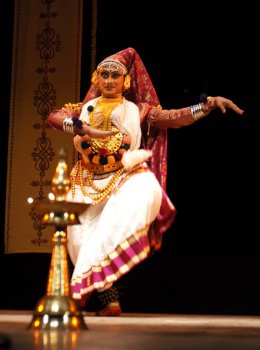 Prabal Gupta
As per the tradition, Prabal began with a technique oriented number Purappadu. Lord Rama was saluted in his expressive abhinaya. The pure dance sequences were filled with the typical and authentic movements of Kathakali. As expected, delineation of Pootana Moksham was the main item of the evening. The well known story drawn from Mahabharatha is about the demoness Pootana, who in the disguise of a beautiful woman comes to infant Krishna and plans to kill him by feeding him through her poisoned breasts but gets killed by the wonder-infant Krishna. This story line was developed on the basis of a raga and talamalika composition by Ashwathi Tirunal. Clad in colourful costume and moving gracefully in a lively Kathakali vocabulary, Prabal impressed the audience with his nuanced abhinaya. His impersonation of the Pootana character was total and complete. 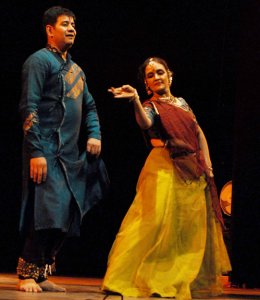 Murali Mohan and Nandini Mehta Next, it was the turn of the mentors of the festival Nandini Mehta and Murali Mohan and their disciples to delight the audience. In their choreography, the dancers made a genuine foray into new channels in Kathak’s movement exploration. Gliding along in stately dignity, leaping, moving in tip-toed delight, it was an artistic interplay of variety of attitudes and movement. Sculpting space in myriad forms the choreography also explored how geometric patterns could evoke certain moods. There were movements epitomizing feminine grace and lyricism. The well trained dancers displayed excellent coordination and no false move dislocated the performance at any stage. Splendidly supported by Ganesh Desai (vocal), Praveen Rao (tabla), Shruthi Kamath (sitar), Prakash (flute), the vibrancy and vivacity of Kathak captivated the lovers of dance. The opening pure nritta part based on Dhamar (14 beats) was enthralling. Likewise, the tarana in Pooriya Dhanashri was classically elegant. Murali Mohan was a class by himself and his satwika oriented abhinaya visualized the meeting of Krishna and his old and intimate friend Sudama on the basis of a thumri (Malkauns). Nandini was a picture of poise in sketching a Hindi composition Chod Bihari (Yaman). 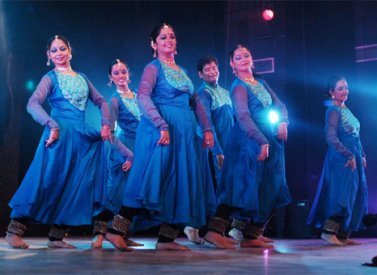 The Nadam troupe Nandini and Murali’s disciples Smita Srinivasan, Poorna Acharya, Arpita Banerjee and Samavitha Sharma did their gurus proud by presenting Varsha. The visual imagery highlights the burst of the clouds accompanied by the rejoicing peacocks, the singing cuckoos, the love in the air, the smell of the earth after the first rain, thunder and lightning and Teentaal, pure technique piece, set to a time cycle of 16 beats. The piece was packed in three different speeds and had vigorous footwork, quick pirouettes, grace and vivacity. 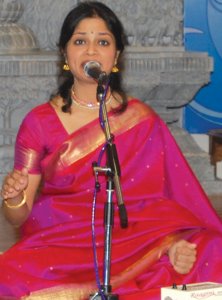 Manasi Prasad
A seasoned and young singer of multi-faceted talents, Manasi Prasad perhaps with improved potency of swara, tone and for felicitous manipulations of her technique without getting obsessed with technical riches displayed what feats she is capable of accomplishing in her recital held at the Gayana Samaj Auditorium during the 11th anniversary music festival of M.A. Narasimhachar Music Foundation. The audience enjoyed the aura and atmosphere of the ragas and krithis that she sang in a wonderfully planned concert. Her musical training and original talents seem to have rightly encouraged independent thinking instead of projecting received ideas. This was evident as much from her exposition of Kaanada as throughout her recital. The grace, suppleness and other allurements of expression as borne out in her lovely Reetigowla for Thyagaraja’s Ragarathnamalikache and tonal elongations in her engrossing vilamba laya left nothing to be desired. The neraval at Bhagavottamulu and kalpanaswaras were impressive. Ranjanimala, a Tanjore Shankaraiyer krithi in a chain of ragas with the word Ranjani tagged, was captivating. The singing of a Dikshitar mega krithi (Chaturdasha ragamalika) Sri Vishwanatham bhaje hum strung in 14 grand ragas - Sri, Arabhi, Gowri, Naata, Gowla, Mohana, Sama, Lalitha, Bhairavi, Saranga, Shankarabharana, Kambhoji, Devakriya, Bhupali with annexed chittaiswaras gave me great joy. Manasi thrilled the rasikas by singing a rare and unique Swati Tirunal ragamalika krithi Saanandam set to Kamalamanohari, Hamsadhwani, Revagupthi, Tarangini ragas. The rendition of the above two krithis created a grand world of music. To add further weight to it came a highly demanding and competently crafted dwi-raga, tana and pallavi in Anandabhairavi and Amrithavarshini ragas. The juxtaposition of shuddha and prathi madhyama ragas alone was a great thought indeed! She went on delineating the ragas almost simultaneously. Her vocal modulations, pruning of voice on the higher pitches, the superb pitching of the taara shadja and a quick flourish over the jeeva swaras of the ragas was patently meritorious. Lovers of music were left spellbound at her artistic feat of singing the pallavi Anandaamrithavarshini Janani paahimaam Apaarakarunaakari Anandabhairavi Sachchidananda Bhairavi with the names of the two ragas inserted in the pallavi line. The handling of the pallavi in different kaalaas and gathis and the placement of kalpanaswaras at different edduppus spoke of Manasi’s extraordinary expertise and musicianship. The accompanists Nalina Mohan (violin), C. Cheluvaraju (who has been awarded Karnataka Sangeetha Nrithya Academy’s award recently for mridanga) and Sukanya Ramgopal (ghata) were in their top form. If Manasi’s performance was pleasing to the ears, the presentation of Bharatanatya and Kathak by experienced Hindustani vocalist-dancer Susheela Mehta and Deepak Maharaj was pleasing to the eyes. Both of them performed on the concluding day of the 13th Kala Nadam festival at the ADA Rangamandira. 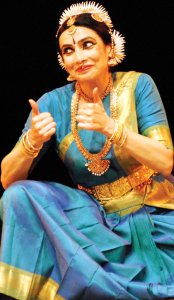 Susheela Mehta Susheela Mehta made her Bharatanatya performance a differently delectable one. Accompanied by Praveen Kumar (nattuvangam), Vasudha Balakrishna (vocal), Jayaram (flute) and Balakrishna (mridanga), she explored her medium in an aesthetic and artistically fetching manner. She delineated the greatness of Ganga, Yamuna and Saraswathi with various connotations. The origin of Ganga was shown and it was explicated in the Yogic sense too referring to them as Pingala, Idaa and Sushmna. The composition (Himasheela kanye, raga and talamalika) by Shatavadhani Ganesh was conceptualized and choreographed by Susheela herself. Swaras and jathis were interspersed at regular intervals to make room for nimble nritta. Her abhinaya was appropriately nuanced and profound. The buoyancy and sturdiness of her nritta was rewarding. 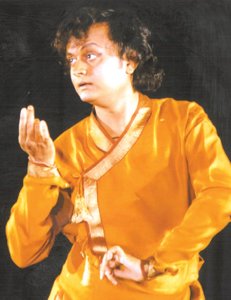 Pt Deepak Maharaj Pt Deepak Maharaj proved himself a worthy son of unequalled Kathak maestro Pt Birju Maharaj. His performance was a journey into the interior spaces of the laya which could accommodate the virtuosic embroidery of pure rhythm without the mood getting broken. Inspiringly accompanied by his elder brother on the tabla and padhanth, he brought out the subtle beauty of upaj, aamad, thaat, udaans, pharans etc, in his teental. There was computer like precision in landing pat on the sam. The chakkars were a delight to watch. The tatkaars and the dialogue between him and the tabla were fetching. Dr. M. Surya Prasad is a well known Academy awardee dance and music critic. He is a regular columnist for Prajavani (on every Tuesday) and The New Indian Express (on every Monday). He has published more than 4500 articles and completed more than 1300 columns of writing in English and Kannada. He is the Professor and Head of the Dept. of Hindi, Vijaya College. |